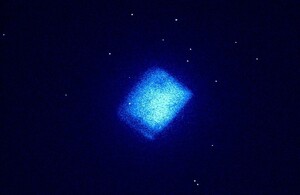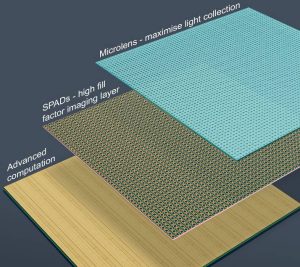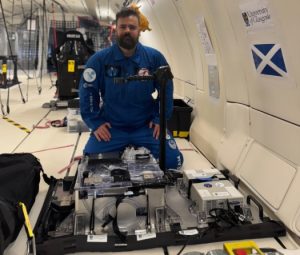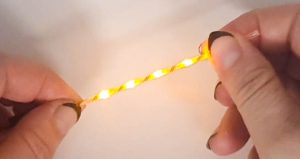You are invited to select – from below – the research project from the last year that you feel will make the largest impact on the commercial market in the next five years. The five universities involved are (alphabetically): Bristol University, Edinburgh University, Glasgow University, both Teesside and Edinburgh universities, and Wolverhampton University
As in previous years, the Electronics Weekly editorial team has selected the shortlist of entrants. And we do ask you to look at all the entrants below before voting.
![]() Loading …
Loading …
THE RESULT WILL BE ANNOUNCED AT THE ELEKTRA AWARDS 2025
Voting closes 1 October 2025.
Bristol University and UKAEA make first carbon-14 diamond battery
 Scientists and engineers from the University of Bristol and the UK Atomic Energy Authority (UKAEA) and have created the world’s first carbon-14 diamond battery. This new type of battery has the potential to power devices for thousands of years, making it an incredibly long-lasting energy source. The picture shows weak radio luminescence, captured by a low light intensity camera, from a synthetic diamond carbon film made from beta-emitting carbon-14 atoms. The battery leverages the radioactive isotope, carbon-14, known for its use in radiocarbon dating, to produce a diamond battery.
Scientists and engineers from the University of Bristol and the UK Atomic Energy Authority (UKAEA) and have created the world’s first carbon-14 diamond battery. This new type of battery has the potential to power devices for thousands of years, making it an incredibly long-lasting energy source. The picture shows weak radio luminescence, captured by a low light intensity camera, from a synthetic diamond carbon film made from beta-emitting carbon-14 atoms. The battery leverages the radioactive isotope, carbon-14, known for its use in radiocarbon dating, to produce a diamond battery.
Edinburgh University spin-out reveals two camera chips with single-photon pixels and DSP
 Singular Photonics has spun out of the University of Edinburgh to offer two ultra-sensitive camera chips based on SPADs – single-photon avalanche detectors. Both have in-sensor digital signal processing. Development has been lead by Professor Robert Henderson, head of Edinburgh’s CMOS Sensors and Systems Group, and a pioneer of SPAD-based image sensors: he co-designed one in 2005, and in 2013 lead the development of STMicroelectronics’ SPAD-based time-of-flight sensor that is in more than a billion smartphones today.
Singular Photonics has spun out of the University of Edinburgh to offer two ultra-sensitive camera chips based on SPADs – single-photon avalanche detectors. Both have in-sensor digital signal processing. Development has been lead by Professor Robert Henderson, head of Edinburgh’s CMOS Sensors and Systems Group, and a pioneer of SPAD-based image sensors: he co-designed one in 2005, and in 2013 lead the development of STMicroelectronics’ SPAD-based time-of-flight sensor that is in more than a billion smartphones today.
Glasgow University patent aids space factory development
 3D printing objects in zero-gravity environments could pave the way for orbital fabricators. Dr Gilles Bailet, of Glasgow Uiversity’s James Watt School of Engineering, has been awarded a patent for a new system which overcomes the challenges of 3D printing in such an environment. A number of applications are in prospect with such a “space factory”, it suggests. For example, manufacturing solar reflectors to generate zero-carbon power for transmission back to Earth. Or perhaps drug research stations that can create specialised pharmaceuticals.
3D printing objects in zero-gravity environments could pave the way for orbital fabricators. Dr Gilles Bailet, of Glasgow Uiversity’s James Watt School of Engineering, has been awarded a patent for a new system which overcomes the challenges of 3D printing in such an environment. A number of applications are in prospect with such a “space factory”, it suggests. For example, manufacturing solar reflectors to generate zero-carbon power for transmission back to Earth. Or perhaps drug research stations that can create specialised pharmaceuticals.
Teesside and Edinburgh universities develop new carbon capture material
 The universities of Teesside and Edinburgh have created a new material which can capture 3.5–5 million tonnes of CO2 in the UK and nearly 30 million tonnes of CO2 globally per year by 2030, at a cost of around £100 per tonne CO2 – considerably less than current direct air capture (DAC) technologies. Known as CalyChar, the new material is an advanced form of hydrochar, a charcoal-like material formed by using heat and water to treat organic/bio waste in a process known as hydrothermal carbonisation (HTC).
The universities of Teesside and Edinburgh have created a new material which can capture 3.5–5 million tonnes of CO2 in the UK and nearly 30 million tonnes of CO2 globally per year by 2030, at a cost of around £100 per tonne CO2 – considerably less than current direct air capture (DAC) technologies. Known as CalyChar, the new material is an advanced form of hydrochar, a charcoal-like material formed by using heat and water to treat organic/bio waste in a process known as hydrothermal carbonisation (HTC).
Wolverhampton University satellites to tackle UK water leakage
 Researchers at Wolverhampton University have secured funding for a space-based project, using Quub satellites, to help tackle UK water leakages. The Wolverhampton team, along with partners, will be working on a project called ‘Space Eye’. The aim is to use the latest satellite technology for faster, more accurate and cost-effective monitoring. Professor Mohammad Patwary, Director of the University’s Digital Innovation and Solution Centre (DISC), is the Academic Lead on the project.
Researchers at Wolverhampton University have secured funding for a space-based project, using Quub satellites, to help tackle UK water leakages. The Wolverhampton team, along with partners, will be working on a project called ‘Space Eye’. The aim is to use the latest satellite technology for faster, more accurate and cost-effective monitoring. Professor Mohammad Patwary, Director of the University’s Digital Innovation and Solution Centre (DISC), is the Academic Lead on the project.
2024
 The winner of last year’s award was Nottingham Trent University, which created washable, stretchable electronics for medical wearables.
The winner of last year’s award was Nottingham Trent University, which created washable, stretchable electronics for medical wearables.
The winning research project was using 4mm diameter elastomer fibres made from a long thin flexible PCB, helically wound along, and bonded to, the elastomer core, with its components facing inwards.
This innovative design means strips of circuitry more complex than a single wire or printed component can be wound into a helix so that the entire circuit can stretch. The team has made prototypes with PCBs of different widths and helix angles around fibres of different diameters and physical properties.
Elektra Awards
The winner of the award – the one that receives the most votes from readers – will be announced at the awards ceremony in December
The Elektra Awards 2025 takes place on Tuesday 9 December at Hilton Bankside, London.
Find out more information about booking your place at the industry’s most prestigious awards.


